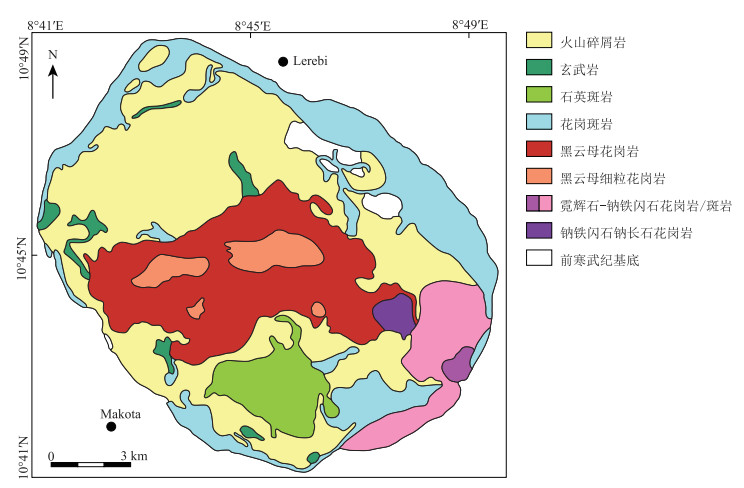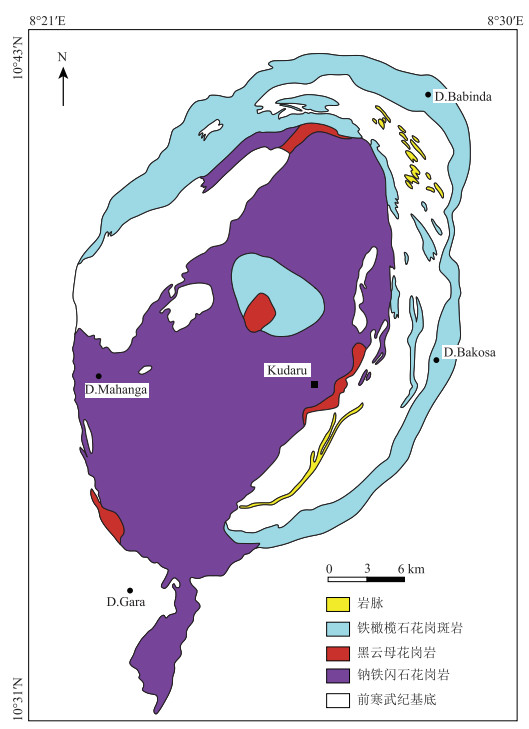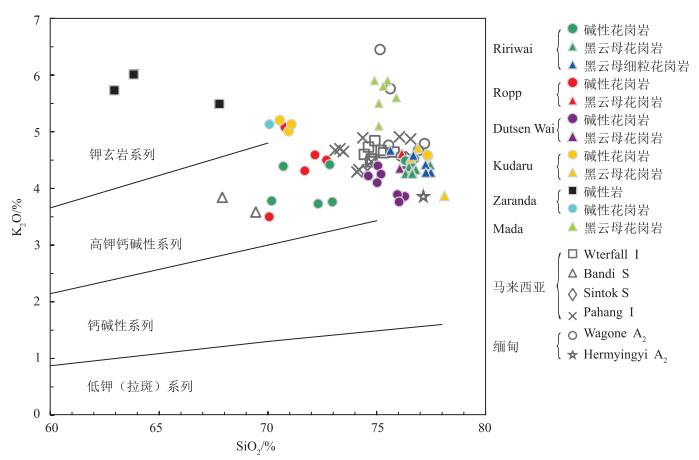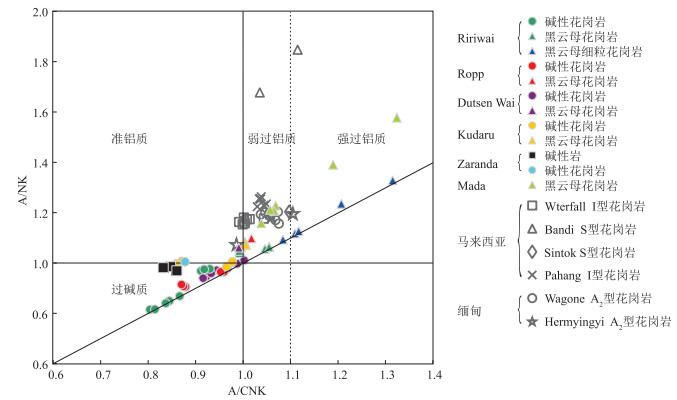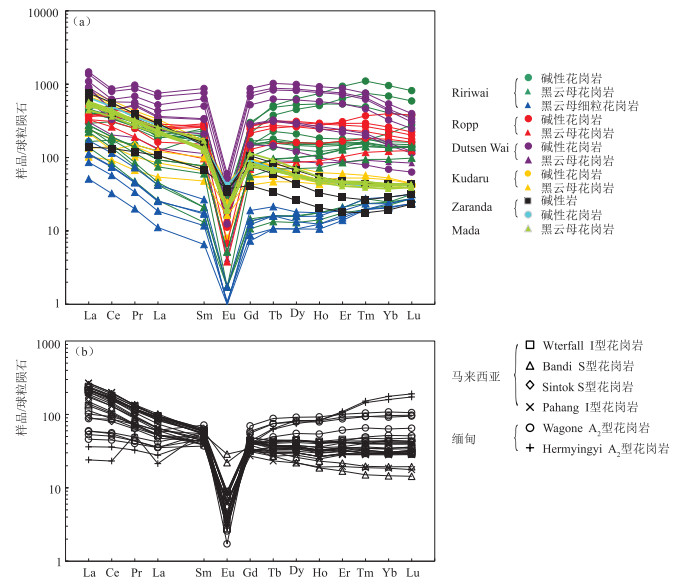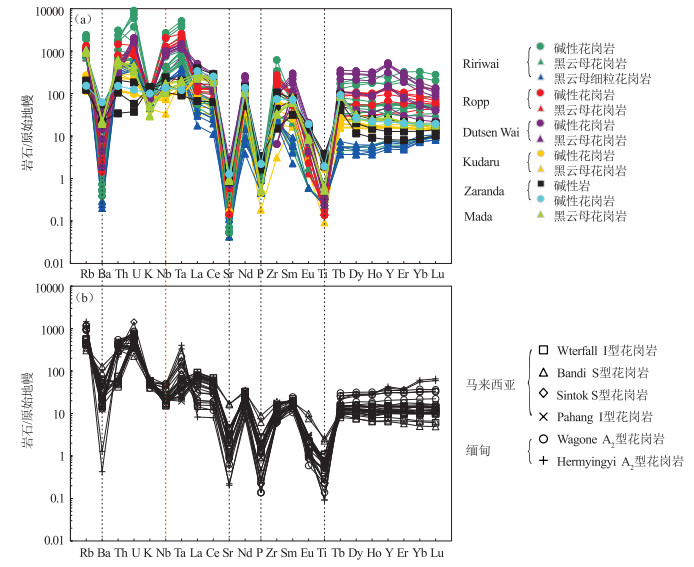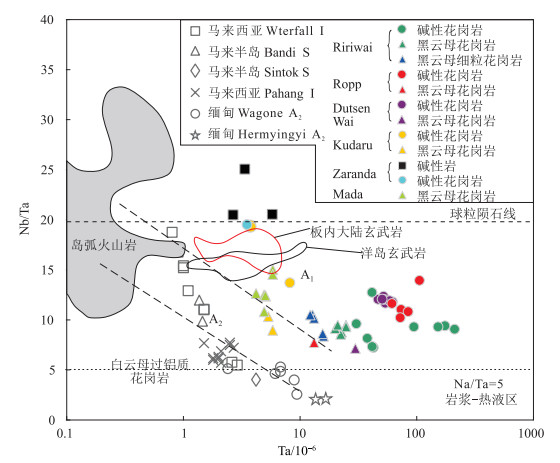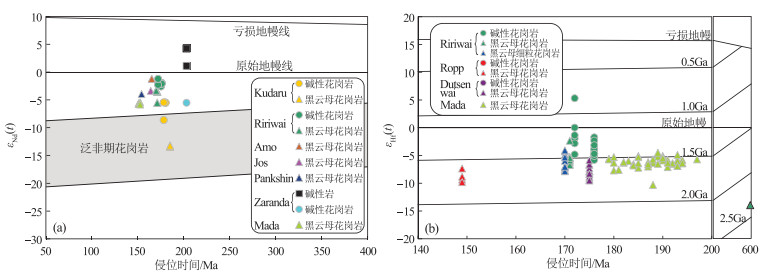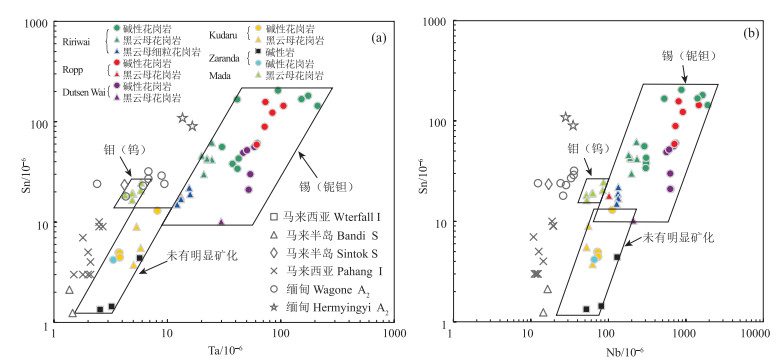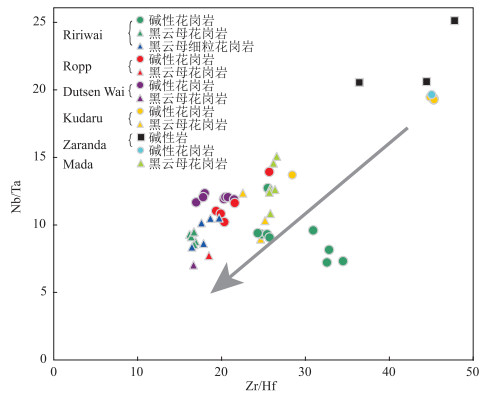Genesis of Mesozoic alkaline granites and biotite granites in Nigeria and its significance for tin-polymetallic prospecting
-
摘要:
尼日利亚中生代环状杂岩中产出丰富的含锡(铌钽)等多金属的花岗岩, 其中与成矿相关且占主体的2种岩石类型是碱性花岗岩和黑云母花岗岩, 前者具有含碱性暗色矿物过碱质特征, 后者具有含黑云母过铝质特征。前人对2种共生的岩石对锡(铌钽)成矿作用可能的制约机制还未深入探讨, 综合分析前人研究资料, 为理解非造山A型花岗岩锡(铌钽)成矿作用提供新视角, 进一步明确找矿方向。2种岩石绝大多数在侏罗纪侵位, 但在同一杂岩体中, 碱性花岗岩锆石结晶普遍稍早于黑云母花岗岩, 且前者分异程度稍弱于后者。碱性花岗岩是起源于富集地幔岩浆在极端分离结晶作用下的产物, 但此过程中有部分地壳物质的混染。过铝质黑云母花岗岩并非与造山型过铝质花岗岩一样来自地壳物质的熔融, 它更可能是来自于碱性花岗岩同一母岩浆演化的另一个混染了更多地壳物质的晚期分支。与俯冲背景的成锡花岗岩一样, 尼日利亚锡多金属富集主要与弱过铝质黑云母花岗岩有关, 受岩浆后期出溶流体的显著影响。碱性花岗岩对锡(铌钽)元素的富集程度, 大致代表了未受出溶流体影响时共生黑云母花岗岩的锡(铌钽)含量。成矿物质来源为泛非基底围岩, 元素的富集成矿主要被分离结晶和流体出溶行为控制。尼日利亚不成矿环状杂岩体中, 黑云母花岗岩和碱性花岗岩的锡(铌钽)含量都偏低, 两者的Sn含量范围为4×10-6~13×10-6; 而对于成矿杂岩体, 两者锡(铌钽)含量基本高于不成矿杂岩体, 但其中与成矿密切相关的黑云母花岗岩锡(铌钽)含量反而较碱性花岗岩偏低, 其中碱性花岗岩Sn含量范围为21×10-6~205×10-6, 黑云母花岗岩Sn含量范围为10×10-6~62×10-6, 表明熔体中成矿元素含量高低及后期流体出溶是决定能否成矿的关键。因此, 高锡(铌钽)含量杂岩体中具有较低Sn含量的黑云母花岗岩是寻找锡多金属矿的第一选择。
Abstract:There are tin(niobium and tantalum)polymetallic granites in the Mesozoic ring complexes in Nigeria. The two main series are alkaline granite and biotite granite. The former is mainly characterized by alkaline mafic minerals and the latter is mainly peraluminous series. The possible restriction mechanism of the two main series on tin(niobium and tantalum)mineralization has not been deeply discussed by predecessors. The comprehensive analysis of previous research data in this paper provides a new perspective for understanding the tin(niobium-tantalum)mineralization of non-orogenic A-type granite and further defines the prospecting direction. Two series both emplaced during the Jurassic. In one complex, the alkaline granite crystallized slightly earlier than the biotite granite and the former is slightly weaker in the degree of differentiation than the latter. Alkaline granites were formed through fractional crystallization of enriched mantle-derived magma and contaminated with a small amount of crustal material. Peraluminous biotite granites unlikely came from the melting of crustal material like orogenic peraluminous granites. Peraluminous biotite granites were more likely to come from the same primitive magma as the alkaline granite but belong to another branch contaminated with more crustal material. However, like the ore-forming granites in the subduction background, the tin-polymetallic enrichment is mainly related to the weakly peraluminous biotite granite in Nigeria, which is significantly affected by the exsolution of fluids during the late-magmatic stage. The enrichment of tin(niobium and tantalum)elements in some alkaline granites roughly represent the content of tin(niobium and tantalum)in the paragenetic biotite granites that had been not affected by fluids. The ore-forming materials were mainly from Pan-African basement rocks, and the enrichment of elements is mainly controlled by the fractional crystallization and fluid exsolution. The content of tin(niobium and tantalum)in the unmineralized ring complexes in Nigeria is relatively low in biotite granite and alkaline granite, whose Sn content range from 4×10-6 to 13×10-6. As for the mineralized ring complexes, the content of tin(niobium and tantalum)is higher than that of the unmineralized complexes. However, the content of tin(niobium and tantalum)in the biotite granite closely related to mineralization is lower than that of the alkaline granite. Sn content range of these alkaline granites and biotite granites are from 21×10-6 to 205×10-6 and 10×10-6 to 62×10-6, respectively. The above evidence shows that the content of ore-forming elements in the melt and the later exsolution of hydrothermal fluids are the key factors to determine the mineralization. Therefore, the biotite granite with low tin(-niobium and tantalum)content in the ring complexes with corresponding high ore-forming elements is the first choice for searching for tin polymetallic deposits.
-
Key words:
- alkaline granite /
- anorogenic /
- Jurassic /
- West Africa /
- niobium and tantalum /
- tin-polymetallic deposit
-

-
图 1 尼日利亚构造划分和稀有金属成矿带简图(据Obaje,2009修改)
Figure 1.
图 2 尼日利亚环状杂岩和锡-铌钽矿点地质简图(据Kinnaird, 1981修改)
Figure 2.
图 3 尼日利亚Ririwai杂岩体地质简图(据Girei et al., 2019修改)
Figure 3.
图 5 尼日利亚Kudaru杂岩体地质简图(据Kamaunji et al., 2020修改)
Figure 5.
图 6 尼日利亚Kudaru、Ririwai、Dutsen Wai、Ropp、Zaranda和Mada花岗岩SiO2-(Na2O+K2O)图解(尼日利亚数据据Girei et al., 2019;2020;Amuda et al., 2020;Kamaunji et al., 2020;Ahmed et al., 2021; 马来西亚数据据Cao et al., 2020;Du et al., 2020;Liu et al., 2020;缅甸数据据Li et al., 2018;底图据Middlemost,1994)
Figure 6.
图 7 尼日利亚Kudaru、Ririwai、Dutsen Wai、Ropp、Zaranda和Mada花岗质岩SiO2-K2O图解(数据来源同图 6,底图据Peccerillo et al., 1976)
Figure 7.
图 8 尼日利亚Kudaru、Ririwai、Dutsen Wai、Ropp、Zaranda和Mada花岗质岩A/CNK-A/NK图解(数据来源同图 6)
Figure 8.
图 9 尼日利亚Kudaru、Ririwai、Dutsen Wai、Ropp、Zaranda和Mada花岗质岩稀土元素配分模式图(数据来源和图 6相同,标准化数据来自Sun et al., 1989)
Figure 9.
图 10 尼日利亚Kudaru、Ririwai、Dutsen Wai、Ropp、Zaranda和Mada花岗质岩微量元素蛛网图(数据来源同图 6,标准化数据据Sun et al., 1989)
Figure 10.
图 11 尼日利亚Kudaru、Ririwai、Dutsen Wai、Ropp、Zaranda和Mada花岗质岩(Zr+Nb+Ce+Y)-(Na2O+K2O)/CaO图解和10000Ga/Al-Y图(数据来源同图 6,底图据Whalen et al., 1987)
Figure 11.
图 12 尼日利亚Kudaru、Ririwai、Dutsen Wai、Ropp、Zaranda和Mada花岗质岩Ta-Nb/Ta变异图解(数据来源同图 6,底图据Ballouard et al., 2020)
Figure 12.
图 13 尼日利亚Kudaru、Ririwai、Amo、Jos、Pankshin、Zaranda、Ropp、Dutsen Wai和Mada花岗质岩Nd和Hf同位素图解(数据据Dada et al., 1995;Dickin et al., 1991;Girei et al., 2019;2020;Kamaunji et al., 2020;Ahmed et al., 2021)
Figure 13.
图 14 尼日利亚Kudaru、Ririwai、Dutsen Wai、Ropp、Zaranda和Mada花岗质岩Ta-Sn(a)和Nb-Sn(b) 微量元素协变图(数据来源同图 6)
Figure 14.
图 15 尼日利亚Kudaru、Ririwai、Dutsen Wai、Ropp、Zaranda和Mada花岗质岩Zr/Hf-Nb/Ta协变图(数据来源同图 6)
Figure 15.
-
[1] Ahmed H A, Wang L X, Ma C Q, et al. Contrasting Neoproterozoic and Mesozoic granitoids in Zaranda Complex(Nigeria): Insights into the distinct origins, tectonic settings and mineralization potential[J]. International Journal of Earth Sciences, 2021, 110: 1389-1413. doi: 10.1007/s00531-021-02021-z
[2] Amuda A K, Yang X, Deng J, et al. Petrogenesis of the peralkaline Dutsen Wai and Ropp complexes in the Nigerian younger granites: implications for crucial metal enrichments[J]. International Geology Review, 2021, 63(16): 2057-2081. doi: 10.1080/00206814.2020.1821250
[3] Bailey D K, Schairer J F. Feldspar-liquid equilibria in peralkaline liquids: the orthoclase effect[J]. American Journal of Science, 1964, 262(10): 1198-1206. doi: 10.2475/ajs.262.10.1198
[4] Bain A D N. The younger intrusive rocks of the Kudaru Hills, Nigeria[J]. Quart. J. Geol. Soc., 1934, 90: 201-234. doi: 10.1144/GSL.JGS.1934.090.01-04.08
[5] Ballouard C, Massuyeau M, Elburg M A, et al. The magmatic and magmatic-hydrothermal evolution of felsic igneous rocks as seen through Nb-Ta geochemical fractionation, with implications for the origins of rare-metal mineralizations[J]. Earth-Science Reviews, 2020, 203: 103-115.
[6] Ballouard C, Poujol M, Boulvais P, et al. Nb-Ta fractionation in peraluminous granites: A marker of the magmatic-hydrothermal transition[J]. Geology, 2016, 44(3): 231-234. doi: 10.1130/G37475.1
[7] Barbarin B. A review of the relationships between granitoid types, their origins and their geodynamic environments[J]. Lithos, 1999, 46(3): 605-626. doi: 10.1016/S0024-4937(98)00085-1
[8] Bau M. Controls on the fractionation of isovalent trace elements In magmatic and aqueous systems: Evidence from Y/Ho, Zr/Hf, and Lanthanide tetrad effect[J]. Contributions to Mineralogy and Petrology, 1996, 123: 323-333. doi: 10.1007/s004100050159
[9] Basak A, Goswami B. The physico-chemical conditions of crystallization of the Grenvillian arfvedsonite granite of Dimra Pahar, Hazaribagh, India: constraints on possible source regions[J]. Mineralogy and Petrology, 2020, 114: 329-356. doi: 10.1007/s00710-020-00708-w
[10] Bennett J N, Turner D C, Ike D C, et al. The geology of some Nigerian anorogenic ring complexes[J]. Overseas Geology & Mineral Resources, 1984, 61: 66.
[11] Bonin B. Les granites des complex esannulaires[M]. Bureau de Recherches Géologiques et Minières, 1982.
[12] Borodulin G P, Chevychelov V Y, Zaraysky G P. Experimental study of partitioning of tantalum, niobium, manganese, and fluorine between aqueous fluoride fluid and granitic and alkaline melts[J]. Doklady Earth Sciences, 2009, 427(1): 868-873. doi: 10.1134/S1028334X09050341
[13] Bowden P, Turner D C. Peralkaline and associated ring-complexes in the Nigeria-Niger province, West Africa[C]// The alkaline rocks. John Wiley, London, 1974: 330-351.
[14] Bowden P, Van Breemen O, Hutchinson J, et al. Palaeozoic and Mesozoic age trends for some ring complexes in Niger and Nigeria[J]. Nature, 1976, 259: 297-299. doi: 10.1038/259297a0
[15] Bowden P, Kinnaird J A. Geology and mineralization of the Nigerian anorogenic ring complexes[J]. Geologisches Jahrb(Hannover)B, 1984, 56: 3-65.
[16] Bowden P, Black R F, Martin E C, et al. Niger-Nigerian alkaline ring complexes: A classic example of African phanerozoic anorogenic mid-plate magmatism[J]. Geological Society Special Publication, 1987, 30: 357-379. doi: 10.1144/GSL.SP.1987.030.01.17
[17] Cao J, Yang X, Du G, et al. Genesis and tectonic setting of the Malaysian waterfall granites and tin deposit: constraints from LA-ICP(MC)-MS zircon U-Pb and cassiterite dating and Sr-Nd-Hf isotopes[J]. Ore Geology Reviews, 2020, 118: 103336. doi: 10.1016/j.oregeorev.2020.103336
[18] Dada S S, Briqueu L, Harms U, et al. Charnockitic and monzonitic Pan-African series from north-central Nigeria: Trace-element and Nd, Sr, Pb isotope constraints on their petrogenesis[J]. Chemical Geology, 1995, 124(3): 233-252.
[19] Dickin A P, Halliday A N, Bowden P. A Pb, Sr and Nd isotope study of the basement and Mesozoic ring complexes of the Jos Plateau, Nigeria[J]. Chemical Geology, 1991, 94: 23-32. doi: 10.1016/S0009-2541(10)80014-2
[20] Du G F, Yang X Y, Cao J Y, et al. Genesis and timing of the Sungai Lembing tin deposit in Pahang, east Malaysia: constraints from LA-CP-MS zircon and cassiterite U-Pb dating, geochemical compositions and Sr-Nd-Hf isotopes[J]. Ore Geology Reviews, 2020, 119: 103364. doi: 10.1016/j.oregeorev.2020.103364
[21] Eby G N. Chemical subdivision of the A-type granitoids: petrogenetic and tectonic implications[J]. Geology, 1992, 20(7): 641-644. doi: 10.1130/0091-7613(1992)020<0641:CSOTAT>2.3.CO;2
[22] Frost C D, Frost B R. On ferroan(A-type)granitoids: their compositional variability and modes of origin[J]. Journal of petrology, 2011, 52(1): 39-53. doi: 10.1093/petrology/egq070
[23] Fyfe W S. Fluids in the Earth's crust: Their significance in metamorphic, tectonic and chemical transport process[M]. Elsevier, 2012.
[24] Girei M B, Li H, Algeo T J, et al. Petrogenesis of A-type granites associated with Sn-Nb-Zn mineralization in Ririwai complex, north-central Nigeria: Constraints from whole-rock Sm-Nd and zircon Lu-Hf isotope systematics[J]. Lithos, 2019, 340/341: 49-70. doi: 10.1016/j.lithos.2019.05.003
[25] Girei M B, Li H, Vincent, V I, et al. Genesis and timing of Mo mineralization in the Mada Ring Complex, north-central Nigeria: insights from whole-rock geochemistry, Nd-Sr isotopes, zircon U-Pb-Hf isotopes, and molybdenite Re-Os systematics[J]. Mineralium Deposita, 2020: 1-20.
[26] Govett G J S. Rock geochemistry in mineral exploration[M]. Amsterdam: Elsevier, 1983: 1-461.
[27] Guo C, Zeng L, Li Q, et al. Hybrid genesis of Jurassic fayalite-bearing felsic subvolcanic rocks in South China: Inspired by petrography, geochronology, and Sr-Nd-O-Hf isotopes[J]. Lithos, 2016, 264: 175-188. doi: 10.1016/j.lithos.2016.08.020
[28] Han B F, Wang S G, Jahn B M, et al. Depleted-mantle source for the Ulungur River A-type granites from North Xinjiang, China: geochemistry and Nd-Sr isotopic evidence, and implications for Phanerozoic crustal growth[J]. Chemical Geology, 1997, 138(3/4): 135-159.
[29] Hodder B W. Tin mining on the Jos Plateau of Nigeria[J]. Economic Geography, 1959, 35(2): 109-122. doi: 10.2307/142394
[30] Hossain M T, Turaki U M. Bibliography on the younger granite ring complexes and Tin mineralization in West Africa with emphasis of Nigeria[J]. Journal of African Earth Sciences, 1983, 1(1): 73-81.
[31] Imeokparia E G. Rare-metal mineralization in granitic rocks of the Tongolo anorogenic complex-Northern Nigeria[J]. Mineralium deposita, 1985, 20(2): 81-88.
[32] Jacobson R R E, MacLeod W N, Black R. Ring complexes in the younger granite province of Northern Nigeria[J]. Geological Society London Memoirs, 1958, 1(1): 5-71. doi: 10.1144/GSL.MEM.1958.001.01.01
[33] Kamaunji V D, Wang L, Ahmed H A, et al. Coexisting A1 and A2 granites of Kudaru complex: Implications for genetic and tectonic diversity of A-type granite in the younger granite province, North-Central Nigeria[J]. International Journal of Earth Sciences, 2020, 109(2): 511-535. doi: 10.1007/s00531-020-01818-8
[34] Kerr A, Fryer B J. Nd isotopic evidence for crust-mantle interaction in the generation of A-type granitoid suites in Labrador, Canada[J]. Chemical Geology, 1993, 104: 39-60. doi: 10.1016/0009-2541(93)90141-5
[35] Kinnaird J A. Mineralization associated with the Nigerian Mesozoic ring complexes[J]. Stud. Geol. Salamanca, 1979, 14: 189-220.
[36] Kinnaird J A, St Andrews University Younger Granite Research Group. Geology of the Nigerian anorogenic ring complexes 1: 500 000[M]. Bartholomew, 1981.
[37] Kinnaird J A. Contrasting styles of Sn-Nb-Ta-Zn mineralization in Nigeria[J]. Journal of African Earth Sciences, 1984, 2(2): 81-90.
[38] Kinnaird J A, Bowden P, Ixer R A, et al. Mineralogy, geochemistry and mineralization of the Ririwai complex, northern Nigeria[J]. Journal of African Earth Sciences, 1985, 3(1/2): 185-222.
[39] Kinnaird J A. Hydrothermal alteration and mineralization of the alkaline anorogenic ring complexes of Nigeria[J]. Journal of African Earth Sciences(1983), 1985, 3(1/2): 229-251.
[40] Kinnaird J A, Nex P A M, Milani L. Tin in Africa[J]. Episodes 2016, 39: 362-380.
[41] Küster D. Rare-metal pegmatites of Wamba, Central Nigeria - their formation in relationship to late Pan-African granites[J]. Mineralium Deposita, 1990, 25: 25-33. doi: 10.1007/BF03326380
[42] Lehmann B. Formation of tin ore deposits: A reassessment[J]. Lithos, 2020, 402/403(1): 105756.
[43] Lehmann B. Metallogeny of tin[M]. Berlin: Springer-Verlag, 1990.
[44] Li H, Myint A Z, Yonezu K, et al. Geochemistry and U-Pb geochronology of the Wagone and Hermyingyi A-type granites, southern Myanmar: implications for tectonic setting, magma evolution and Sn-W mineralization[J]. Ore Geology Reviews, 2018, 95: 575-592. doi: 10.1016/j.oregeorev.2018.03.015
[45] Linnen R L, Pichavant M, Holtz F. The combined effects of fO2 and melt composition on SnO2 solubility and tin diffusivity in haplogranitic melts[J]. Geochimica et Cosmochimica Acta, 1996, 60(24): 4965-4976. doi: 10.1016/S0016-7037(96)00295-5
[46] Linnen R L, Keppler H. Columbite solubility in granitic melts: Consequences for the enrichment and fractionation of Nb and Ta in the Earth's crust[J]. Contributions to Mineralogy and Petrology, 1997, 128(2/3): 213-227.
[47] Linnen R L. The solubility of Nb-Ta-Zr-Hf-W in granitic melts with Li and Li+ F, constraints for mineralization in rare metal granites and pegmatites[J]. Economic Geology, 1998, 93(7): 1013-1025. doi: 10.2113/gsecongeo.93.7.1013
[48] Liu L, Hu R Z, Zhong H, et al. Petrogenesis of multistage S-type granites from the malay peninsula in the southeast Asian tin belt and their relationship to Tethyan evolution[J]. Gondwana Research, 2020, 84: 20-37. doi: 10.1016/j.gr.2020.02.013
[49] Manning D A C. The effect of fluorine on liquidus phase: Relationships in the system Qz-Ab-Or with excess water at 1kb[J]. Contributions to Mineralogy and Petrology, 1981, 76(2): 206- 215. doi: 10.1007/BF00371960
[50] Mao J, Zheng W, Xie G, et al. Recognition of a middle-late jurassic arc-related porphyry copper belt along the southeast china coast: geological characteristics and metallogenic implications[J]. Geology, 2021, 49(5): 592-596. doi: 10.1130/G48615.1
[51] Martin R F, Bowden P. Peraluminous granites produced by rock-fluid interaction in the Ririwai nonorogenic ring-complex, Nigeria: Mineralogical evidence[J]. The Canadian Mineralogist, 1981, 19: 65-82.
[52] Melcher F, Graupner T, Hans-Eike Gäbler, et al. Tantalum-(niobium-tin)mineralisation in african pegmatites and rare metal granites: constraints from Ta-Nb oxide mineralogy, geochemistry and U-Pb geochronology[J]. Ore Geology Reviews, 2015, 64: 667-719. doi: 10.1016/j.oregeorev.2013.09.003
[53] Middlemost E A K. Naming materials in the magma/igneous rocksystem[J]. Earth Science Reviews, 1994, 37(3/4): 215-224.
[54] Naski G C, Hess P C. SnO2 solubility: experimental results in peraluminous and peralkaline high silica glasses[J]. Trans. Am. Geophys. Union(Eos), 1985, 66: 412.
[55] Ngako V, Njonfang E, Aka F T, et al. The North-South Paleozoic to Quaternary trend of alkaline magmatism from Niger-Nigeria to Cameroon: Complex interaction between hotspots and Precambrian faults[J]. Journal of African Earth Sciences, 2006, 45(3): 241-256. doi: 10.1016/j.jafrearsci.2006.03.003
[56] Obaje N. Geology and mineral resources of Nigeria[M]. London: Springer Dordrecht Heidelberg, 2009.
[57] Oyawoye M O. Bauchite: a new variety in the quartz monzonite series[J]. Nature, 1965, 205: 689. doi: 10.1038/205689a0
[58] Pastor J, Ogezi A E. New evidence of cassiterite-bearing Precambrian basement rocks of the Jos Plateau, Nigeria-the Gurum case study[J]. Mineralium Deposita, 1986, 21(1): 81-83.
[59] Pearce J A, Harris N B W, Tindle A G. Trace element discrimination diagrams for the tectonic interpretation of granitic rocks[J]. Journal of Petrology, 1984, 25: 956-983. doi: 10.1093/petrology/25.4.956
[60] Pearce J A. Sources and settings of granitic rocks[J]. Episodes, 1996, 19: 120-125. doi: 10.18814/epiiugs/1996/v19i4/005
[61] Peccerillo A, Taylor S R. Geochemistry of Eocene calc-alkaline volcanic rocks from the Kastamonu area, northern Turkey[J]. Contributions to Mineralogy and Petrology, 1976, 58: 63-81. doi: 10.1007/BF00384745
[62] Sawkins F J. Metal deposits in relation to plate tectonics[M]. Berlin: Springer-Verlag, 1984.
[63] Shellnutt J G, Zhou M F. Permian peralkaline, peraluminous and metaluminous A-type granites in the Panxi district, SW China: Their relationship to the Emeishan mantle plume[J]. Chemical Geology, 2007, 243: 286-316. doi: 10.1016/j.chemgeo.2007.05.022
[64] Siegel K, Vasyukova O V, Williams-Jones A E. Magmatic evolution and controls on rare metal-enrichment of the Strange Lake A-type peralkaline granitic pluton, Québec-Labrador[J]. Lithos, 2018, 308/309: 34-52. doi: 10.1016/j.lithos.2018.03.003
[65] Sillitoe R H. Tin mineralization above mantle hot spots[J]. Nature, 1974, 248: 497-499. doi: 10.1038/248497a0
[66] Sörensen H. The alkaline rocks[M]. John Wiley and Sons, 1974.
[67] Stempork M. Intrusion sequences within ore-bearing granitoid plutons[J]. Geological Journal, 1990, 25(3/4): 413-417.
[68] Sun S, McDonough W F. Chemical and isotopic systematics of oceanic basalts: implications for mantle compositions and processes[J]. Geological Society, London, Special Publications, 1989, 42(1): 313-345. doi: 10.1144/GSL.SP.1989.042.01.19
[69] Taylor J R, Wall V J. The behavior of tin in granitoid magmas[J]. Economic Geology, 1992, 87(2): 403-420. doi: 10.2113/gsecongeo.87.2.403
[70] Vincent V I, Li H, Girei M B, et al. Genesis and age of Pb-Zn mineralization from the Ningi-Burra ring complex, North Central Nigeria: Constraints from zircon morphology, U-Pb dating and Lu-Hf isotopes[J]. Lithos, 2021: 106115.
[71] Webster J D. Exsolution of magmatic volatile phases from Cl-enriched mineralizing granitic magmas and implications for ore metal transport[J]. Geochimica et Cosmochimica Acta, 1997, 61: 1017-1029. doi: 10.1016/S0016-7037(96)00395-X
[72] Whalen J B, Currie K L, Chappell B W. A-type granites: geochemical characteristics, discrimination and petrogenesis[J]. Contributions to Mineralogy and Petrology, 1987, 95: 407-419. doi: 10.1007/BF00402202
[73] Wickham S M, Alberts A D, Litvinovsky B A, et al. A stable isotope study of anorogenic magmatism in East Central Asia[J]. Journal of Petrology, 1996, 37: 1063-1095. doi: 10.1093/petrology/37.5.1063
[74] Yang J H, Wu F Y, Wilde S A, et al. Petrogenesis of an alkali syenite-granite-rhyolite suite in the Yanshan Fold and Thrust Belt, Eastern North China Craton: geochronological, geochemical and Nd-Sr-Hf isotopic evidence for lithospheric thinning[J]. Journal of Petrology, 2008, 49(2): 315-351.
[75] Yang W, Niu H, Li N, et al. Enrichment of REE and HFSE during the magmatic-hydrothermal evolution of the Baerzhe alkaline granite, NE China: Implications for rare metal mineralization[J]. Lithos, 2020, 358/359: 105411. doi: 10.1016/j.lithos.2020.105411
[76] Zhao P L, Chu X, Williams-Jones, et al, The role of phyllosilicate partial melting in segregating tungsten and tin deposits in W-Sn metallogenic provinces[J]. Geology, 2021, 50(1): 121-125.
[77] 陈骏, 王汝成, 周建平, 等. 锡的地球化学[M]. 南京: 南京大学出版社, 2000, 116-154.
[78] 曹亮, 崔森, 胡鹏, 等. 尼日利亚矿产资源开发现状及投资环境[J]. 地质通报, 2022, 41(1): 167-183. http://dzhtb.cgs.cn/gbc/ch/reader/view_abstract.aspx?file_no=20220113&flag=1
[79] 胡鹏, 姜军胜, 张海坤, 等. 西非克拉通优势金属矿产地质特征、成矿作用及开发现状[J]. 华南地质, 2022, 38(4): 614-625. https://www.cnki.com.cn/Article/CJFDTOTAL-HNKC202204003.htm
[80] 李建康, 李鹏, 王登红, 等. 中国铌钽矿成矿规律[J]. 科学通报, 2019, 64(15): 1545-1566. https://www.cnki.com.cn/Article/CJFDTOTAL-KXTB201915002.htm
[81] 林德松. 与碱性花岗岩有关的稀有稀土矿床[J]. 矿产与地质, 1994, 44(8): 401-406. https://www.cnki.com.cn/Article/CJFDTOTAL-KCYD406.000.htm
[82] 刘家远, 喻亨祥, 吴郭泉. 新疆北部卡拉麦里富碱花岗岩带的碱性花岗岩与锡矿[J]. 有色金属矿产与勘查, 1997, (3): 2-8. https://www.cnki.com.cn/Article/CJFDTOTAL-YSJS703.000.htm
[83] 莫少剑. 与"超基性岩"有关的锡矿新类型[J]. 地质地球化学, 1986, (1): 54-56. https://www.cnki.com.cn/Article/CJFDTOTAL-DZDQ198601010.htm
[84] 隋清霖, 祝红丽, 孙赛军, 等. 锡的地球化学性质与华南晚白垩世锡矿成因[J]. 岩石学报, 2020, 36(1): 23-34. https://www.cnki.com.cn/Article/CJFDTOTAL-YSXB202001004.htm
[85] 吴福元, 刘志超, 刘小驰, 等. 喜马拉雅淡色花岗岩[J]. 岩石学报, 2015, 31(1): 1-36. https://www.cnki.com.cn/Article/CJFDTOTAL-YSXB202207020.htm
[86] 杨富全, 毛景文, 闫升好. 新疆东准噶尔贝勒库都克锡矿床成矿时代及成矿作用[J]. 地质论评, 2008, 54(5): 626-640. https://www.cnki.com.cn/Article/CJFDTOTAL-DZLP200805010.htm
[87] 袁顺达, 赵盼捞, 刘敏. 与花岗岩有关锡矿成岩成矿作用研究若干问题讨论[J]. 矿床地质, 2020, 39(4): 607-618. https://www.cnki.com.cn/Article/CJFDTOTAL-KCDZ202004006.htm
[88] 张继纯, 严永祥, 王建雄, 等. 西非矿产资源的地质背景及重要成矿分区[J]. 华南地质与矿产, 2019, 35(1): 76-89. https://www.cnki.com.cn/Article/CJFDTOTAL-HNKC201901009.htm
-



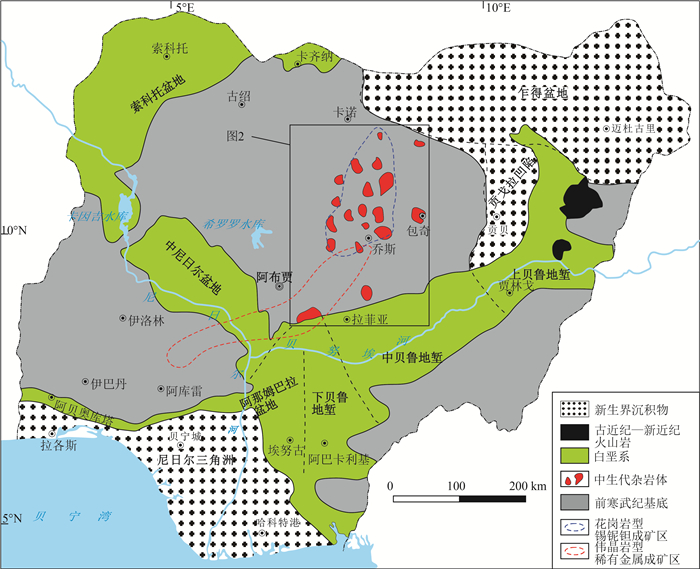
 下载:
下载:

